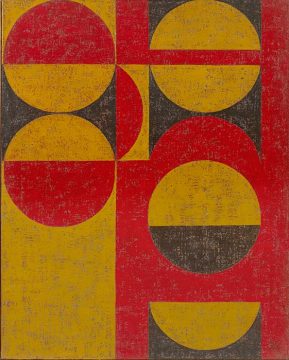Frieze
Why Are So Many Great Artworks Acquired by Museums Locked Away in Storage?


In a darkened temperature-controlled room sit several seminal artworks the public has never seen. Hoards of could-be national treasures populate vast storage vaults. All of them out of view and consideration. What makes an artwork acquired by a museum worthy of wall space, while others are locked away? While efforts have been made behind the scenes to balance collections through acquiring more work by people of colour, this isn’t always reflected in what public eyes see. Hoisting up this much-needed discussion about what museums choose to collect and to show, ‘Speech Acts: Reflection-Imagination-Repetition’ at Manchester Art Gallery curated by Hammad Nasar with Kate Jesson, impels viewers to consider art history’s negative space and also the ways in which our encounters with art are inherently shaped by what is shown and what isn’t.
Constructed from the findings of Black Artists & Modernism (BAM) – a research project led by artist Sonia Boyce with the University of the Arts London and Middlesex University which examines the ways practicing UK artists of African and Asian descent have been integrated into the story of art – the show critiques the processes that underlie the construction – and curation – of art history. Drawn from four nearby public collections – Cartwright Hall Art Gallery, Bradford, John Rylands Library (The University of Manchester), Manchester Art Gallery and the Whitworth – the exhibition brings forward a fraction of these collections’ overlooked pieces and places them next to works by artists with far greater public stature. Featuring the works of a diverse list of 40 artists, from Lubaina Himid, Gilbert and George, Anwar Jalal Shemza, Do Ho Suh and William Rothenstein, in total 70 works and archival documents ranging from the 18th to the 21st century make up this exhibition which has been separated into three parts. ‘Reflection’ explores portraiture, the performance of self and how artists, from different times, social classes and backgrounds, situate themselves in relation to histories and expectations. James Northcote’s glowing portrait of Ira Aldridge, the 19th-century African American actor famed for his portrayal of Othello, is subtly operatic. It is the first work acquired by Manchester Art Gallery, bought in 1827, and is a striking ice-breaker to the debate. In Wyndham Lewis’s Portrait of the Artist as the Painter Raphael (1921), the artist, who is known for depicting himself in various personas, presents a solemn portrait of himself as the Italian painter, while Hetain Patel’s video installation, The Other Suit (2015) brings this section to present times through his references to pop cultural male archetypes from Hollywood such as Michael Jackson and Superman.
What enables art to circulate and who gets to be included in these larger shared stories? The ‘Imagination’ section looks to pick up the question through its reconstruction of the LYC Museum & Art Gallery (1972–83), a museum-as-artwork and community hub run by Chinese artist, curator and poet Li Yuan-chia which was housed in a dilapidated barn in Cumbria, bought from the painter Winifred Nicholson. It displayed the work of more than 300 artists including Nicholson, Elsa Stansfield and Madelon Hooykaas and Shelagh Wakely, yet received little acknowledgement or acclaim in British art history. What makes this part of the show effective in countering the canon, is that it also features the work of the ‘School of London’ – artists who have dominated public collections. From William Rothenstein’s Rabindranath Tagore (1912) a delicate pencil on paper depiction of the Indian poet, to Francis Bacon’s cool-toned Portrait of Lucian Freud (1964), we are able to see that the positioning of these artists granted them the hypervisibility needed to steer style, narrative and message, at a greater speed and scale than others. Despite the overall theme of the exhibition exploring the erasure of artists from certain demographics, the inclusion of famous artists such as Frank Auerbach, David Hockney and RB Kitaj means that the show doesn’t end up becoming a tokenistic one-off, othering the very people it is attempting to acknowledge.
Finally, ‘Repetition’ aims to unify the key role of pattern and reiteration across cultures. Works on cloth such as Barbara Brown’s Piazza and Anwar Jalal Shemza’s War Sonnet (1969) show gorgeous compositions that bring an alternative aesthetic and materiality to the space. The use of repeated lines play-up to the idea of optical illusions which fit well with Bridget Riley’s Zephyr (1976) and the excited trembling of its undulated geometric stripes. While this section of the show is less didactic about its politics than the others, its positioning in the discourse is to reframe who we think about when we think about modernism and conceptual art.
Writing in the exhibition’s foreword, Boyce reflects on artist and writer Rasheed Araeen’s past remarks that if a black-British artist’s work is purchased by a public collection, it inevitably goes into cold storage, never to be seen again. What’s clear about the show’s agenda is that race and heritage cannot be taken out of the equation when examining which works become pillars of the zeitgeist. ‘Speech Acts: Reflection-Imagination-Repetition’ asks much more questions than it answers, but considering this is uncharted land, it’s important that we first hypothesise with the right tone before making dogmatic statements. There are tangible acts, strategies and work that must go into fixing how our art collections are constructed and presented – and that doesn’t end with acquisition. The ultimate mission must be to consistently challenge, debate and call-out the homogeny of museums collections and hangs. If art reflects life, then museums need to show us the art, by the artists, that reflect our times.